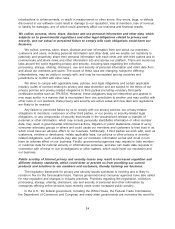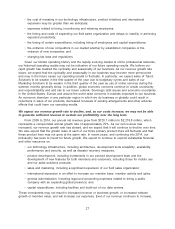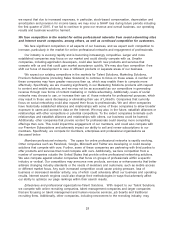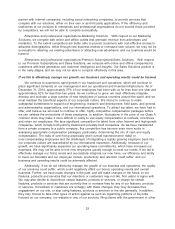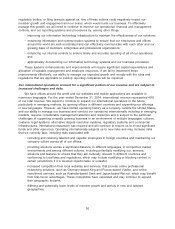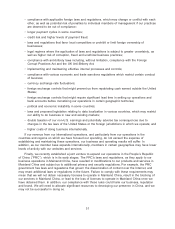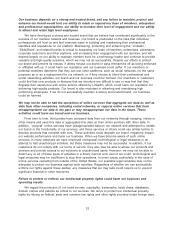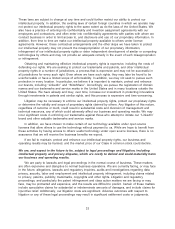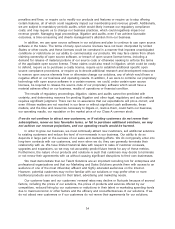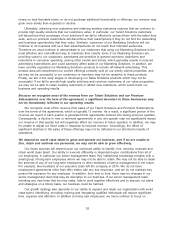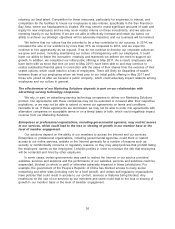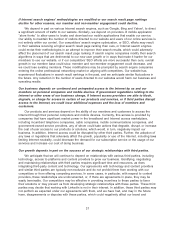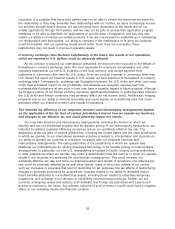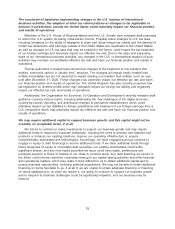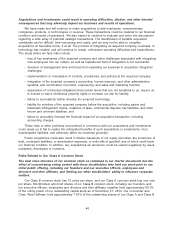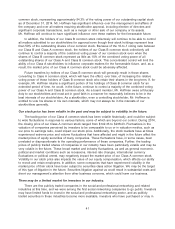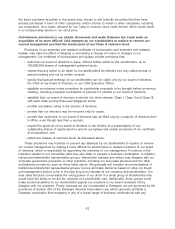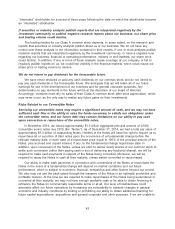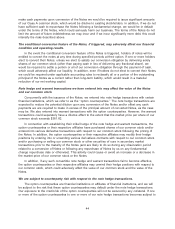LinkedIn 2014 Annual Report Download - page 36
Download and view the complete annual report
Please find page 36 of the 2014 LinkedIn annual report below. You can navigate through the pages in the report by either clicking on the pages listed below, or by using the keyword search tool below to find specific information within the annual report.penalties and fines, or require us to modify our products and features or require us to stop offering
certain features, all of which could negatively impact our membership and revenue growth. Additionally,
we are subject to mandatory periodic audits, which would likely increase our regulatory compliance
costs, and may require us to change our business practices, which could negatively impact our
revenue growth. Managing legal proceedings, litigation and audits, even if we achieve favorable
outcomes, is time-consuming and diverts management’s attention from our business.
In addition, we use open source software in our solutions and plan to continue to use open source
software in the future. The terms of many open source licenses have not been interpreted by United
States or other courts, and these licenses could be construed in a manner that imposes unanticipated
conditions or restrictions on our ability to commercialize our products. We may face claims from others
claiming ownership of open source software, or breach of open source license terms, including a
demand for release of material portions of our source code or otherwise seeking to enforce the terms
of the applicable open source license. These claims could also result in litigation, which could be costly
to defend, require us to purchase a costly license, require us to establish additional specific open
source compliance procedures, or require us to devote additional research and development resources
to remove open source elements from or otherwise change our solutions, any of which would have a
negative effect on our business and operating results. In addition, if we were to combine our proprietary
technology with open source software in a certain manner, we could, under certain open source
licenses, be required to release the source code of our proprietary software which would have a
material adverse effect on our business, results of operations or financial condition.
The results of regulatory proceedings, litigation, claims and audits cannot be predicted with
certainty, and determining reserves for pending litigation and other legal, regulatory and audit matters
requires significant judgment. There can be no assurance that our expectations will prove correct, and
even if these matters are not resolved in our favor or without significant cash settlements, these
matters, and the time and resources necessary to litigate or, resolve them, could harm our business,
our operating results, our reputation or the market price of our Class A common stock.
If we do not continue to attract new customers, or if existing customers do not renew their
subscriptions, renew on less favorable terms, or fail to purchase additional solutions, we may
not achieve our revenue projections, and our operating results would be harmed.
In order to grow our business, we must continually attract new customers, sell additional solutions
to existing customers and reduce the level of non-renewals in our business. Our ability to do so
depends in large part on the success of our sales and marketing efforts. We do not typically enter into
long-term contracts with our customers, and even when we do, they can generally terminate their
relationship with us. We have limited historical data with respect to rates of customer renewals,
upgrades and expansions, so we may not accurately predict future trends for any of these metrics.
Furthermore, the nature of our products and solutions is such that customers may decide to terminate
or not renew their agreements with us without causing significant disruptions to their own businesses.
We must demonstrate that our Talent Solutions are an important recruiting tool for enterprises and
professional organizations and that our Marketing and Sales Solutions provide them with access to an
audience of one of the most influential, affluent and highly educated audiences on the Internet.
However, potential customers may not be familiar with our solutions or may prefer other or more
traditional products and services for their talent, advertising and marketing needs.
Our customer base and our customers’ renewal rates may decline or fluctuate because of several
factors, including the prices of our solutions, the prices of products and services offered by our
competitors, reduced hiring by our customers or reductions in their talent or marketing spending levels
due to macroeconomic or other factors and the efficacy and cost-effectiveness of our solutions. If we
do not attract new customers or if our customers do not renew their agreements for our solutions,
34


